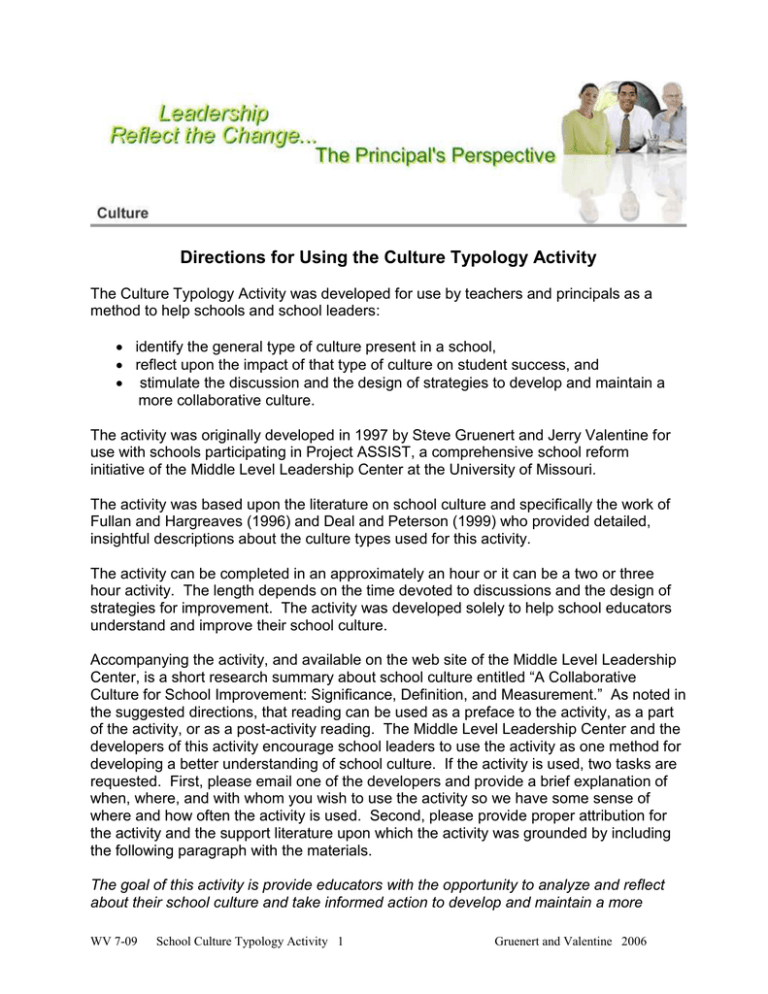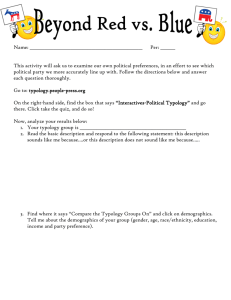Directions for Using the Culture Typology Activity
advertisement

Directions for Using the Culture Typology Activity The Culture Typology Activity was developed for use by teachers and principals as a method to help schools and school leaders: identify the general type of culture present in a school, reflect upon the impact of that type of culture on student success, and stimulate the discussion and the design of strategies to develop and maintain a more collaborative culture. The activity was originally developed in 1997 by Steve Gruenert and Jerry Valentine for use with schools participating in Project ASSIST, a comprehensive school reform initiative of the Middle Level Leadership Center at the University of Missouri. The activity was based upon the literature on school culture and specifically the work of Fullan and Hargreaves (1996) and Deal and Peterson (1999) who provided detailed, insightful descriptions about the culture types used for this activity. The activity can be completed in an approximately an hour or it can be a two or three hour activity. The length depends on the time devoted to discussions and the design of strategies for improvement. The activity was developed solely to help school educators understand and improve their school culture. Accompanying the activity, and available on the web site of the Middle Level Leadership Center, is a short research summary about school culture entitled “A Collaborative Culture for School Improvement: Significance, Definition, and Measurement.” As noted in the suggested directions, that reading can be used as a preface to the activity, as a part of the activity, or as a post-activity reading. The Middle Level Leadership Center and the developers of this activity encourage school leaders to use the activity as one method for developing a better understanding of school culture. If the activity is used, two tasks are requested. First, please email one of the developers and provide a brief explanation of when, where, and with whom you wish to use the activity so we have some sense of where and how often the activity is used. Second, please provide proper attribution for the activity and the support literature upon which the activity was grounded by including the following paragraph with the materials. The goal of this activity is provide educators with the opportunity to analyze and reflect about their school culture and take informed action to develop and maintain a more WV 7-09 School Culture Typology Activity 1 Gruenert and Valentine 2006 collaborative culture. Gruenert and Valentine developed the School Culture Typology Activity in 1997 at the Middle Level Leadership Center, University of Missouri. The developers revised the activity in 2000 and 2006. The literature about school culture, specifically culture “types” from the writings of Fullan and Hargreaves (1996) and Deal and Peterson (1999) as cited in the MLLC research summary entitled “A Collaborative Culture for School Improvement: Significance, Definition, and Measurement,” was instrumental in the development of the activity. Both writings are excellent sources of insight about organizational culture and recommended readings. Following are the recommended directions for using the activity. 1. Provide a brief overview of school culture, particularly the significant relationships between a highly collaborative school culture, school effectiveness, and student success. To make the learning experience more effective, we recommend that you not yet detail the discussion of culture by discussing the “culture types” from the literature, but rather be more general about what culture is, what shapes a school’s culture, and why a collaborative culture is so important. The reason for this omission during this discussion will be evident later in the activity. 2. Distribute the Culture Typology Individual Worksheet and the Cultural Typology Row Explanations. Ask participants to individually (independently) complete the Worksheet per the directions at the top of the sheet, using the Row Explanations sheet as needed to understand the row descriptors. Note that we ask participants to distribute 10 points across the statement options for each row. Initially, we asked participants to select the option that was “most” descriptive of the school. Both approaches work effectively. We obviously prefer the “point distribution” approach, but it does take a few more minutes for participants to ponder the point distribution than to simply select the most descriptive option. However, in the long run it works best because participants are able to better describe their school with the ability to distribute points to multiple responses. 3. Following completion of the Culture Typology Worksheet, we recommend that you do one of the following. Your choice probably depends on the level of trust between the group and the activity facilitator. a. Ask everyone to write their name on the Worksheet and collect the Worksheets from the group for use later in the activity. b. Ask everyone to place their Worksheet face down on the table and leave them face down until the facilitator asks them to return to the Worksheet. 4. If the participants are not currently divided into groups around tables or in circled chairs, move the participants into groups of 6-8 per group. Then distribute one of the Culture Typology Example worksheets to each group. There are three examples pre-developed for this activity. If you have three groups, each gets one example. If you have six groups, two groups get the same example, etc. The goal of the examples is for the group to study their respective example and given their understanding of school culture, identify three or four adjectives that would describe the overall culture of the school. Be sure they have developed those adjectives before moving to the next task. 5. Distribute to participants (still in small groups) the Culture Typology Descriptions sheet. Provide them with the time to read the descriptions and ask WV 7-09 School Culture Typology Activity 2 Gruenert and Valentine 2006 them to compare the descriptions with the adjectives they developed to describe the typology examples. 6. At this point, you can distribute the MLLC Culture Research Summary entitled “A Collaborative Culture for School Improvement: Significance, Definition, and Measurement,” and ask participants to read and discuss the summary. This task could be done in a variety of ways. Our recommendation is to ask everyone to take ten minutes and read it silently, mining for key concepts, marking those with a highlighter, and being prepared to discuss the concepts and main points of the article with small group colleagues. This portion of the activity could take 20-30 minutes, so if time is a concern it could be omitted and participants could be provided the Summary and encouraged to read it after the activity. The summary could also be provided as a pre-activity reading, but that will narrow the range of discovery for item four above. Yet, it could also expand the range of discussion for that item. Generally, knowing the participants provides the answer whether to use the Summary as a pre-reading, a during-activity reading, or a post-reading. 7. Ask several or all of the small groups to share-out with the whole group, briefly describing their worksheet profile example and then sharing the adjectives they believe described their school example. Then ask them to describe their school’s profile based upon the Culture Typology Descriptions sheet. 8. With participants still in groups, distribute back to the participants the individual Typology Worksheet they completed in item 2 above. Provide a copy of the School Culture Typology Consensus Worksheet to the group and ask that one member of each group be designated as the recorder of the group’s work on the sheet. Ask each group to discuss their school’s culture and complete a “group” consensus worksheet (emphasize consensus). Some groups will talk about the items and reach a consensus, while others will struggle with that task and simply go to a mathematical average of the items based upon their individual ratings. Both work adequately, but the consensus discussion method works best as a means toward a deeper understanding of the school’s culture. Once the group consensus worksheet is completed, be sure to ask the recorder to label the worksheet by group or table number to ensure that all sheets are collected at a later time. 9. With participants still in groups, ask them to complete the Culture Typology Reflection Worksheet. This can be done either individually or as a group, or individually first and then as a group. This reflection was designed to foster a deeper understanding of the school’s culture, identify why the culture is the way it is, and begin to develop some ideas/notions/strategies of how to evolve the culture so it is more collaborative. This reflection about what we are, what has precipitated us getting there, and what we can do to move the culture toward a more effective collaborative culture (and/or maintain that culture if the school already has a highly collaborative culture) is critical. Obviously, this culture activity has been implemented to produce this level of discussion among members of the organization. We recommend taking the time to share out the groups’ comments and write them on tear sheets. In addition, we recommend collecting the group’s Reflection Worksheet (group response) from each group. 10. Note that at this time you want to be sure to collect the two group consensus worksheets from the groups. The purpose for collecting these worksheets is so the work of the faculty can be summarized and returned to the faculty. This WV 7-09 School Culture Typology Activity 3 Gruenert and Valentine 2006 summarization is usually best accomplished by a school improvement team, leadership team, or school culture task force or committee. a. School Culture Typology Consensus Worksheet b. Culture Typology Reflection Worksheet 11. Finally, remember to schedule some follow-up activities to discus and study school culture, e.g. completion of the School Culture Survey described in the MLLC School Culture Research Summary and study of the findings from that survey. Subsequent discussions and revisiting the culture typology activity each year allow a school to observe the progress toward a more collaborative culture. Other activities and readings can be substituted or infused into a periodic discussion and analysis of the school’s culture. We don’t change by sticking our heads in the sand and ignoring less productive school cultures. If we understand the importance of a collaborative school culture and the factors that contribute to the culture, we can at least work to become a more collaborative culture. Even becoming a “contrived” culture may be a valuable step toward becoming a truly collaborative culture. Good luck with your efforts. WV 7-09 School Culture Typology Activity 4 Gruenert and Valentine 2006
